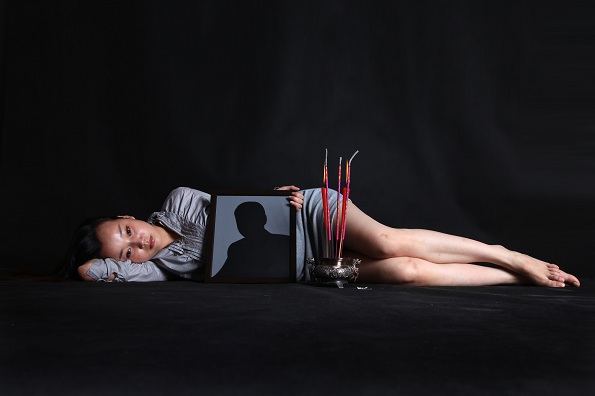Turning the horror of a massive earthquake into a world premiere Melbourne Festival piece
By Paul Ransom.
“The main impact is that your body just doesn’t forget,” explains Sara Brodie.
For the Christchurch born choreographer and creative force behind Fault Lines, (a tri-national collaboration between New Zealand, China and the Melbourne Festival), the earthquake experience is not just a news event. She had a production in season when her hometown was struck by the deadly 2011 quake. “Your nerve endings are all spring loaded,” she adds. “It’s a sensitivity; even to someone moving on the sofa.”
However, Fault Lines is bigger than Brodie’s own quake drama because at the centre of the work are the renowned Leshan Song & Dance Troupe from Sichuan Province in south west China, which was devastated in 2008 by an earthquake that killed 69,000 people and left whole towns in permanent ruin.
As an artist and fellow quake survivor, Brodie was clearly inspired by the opportunity to work with Leshan. “To go overseas and meet dancers from the other side of the earth who’d been through the same thing was quite an incredible journey,” she recalls. “It was really very humbling for me last November when I went to the epicentre of the quake to see that the Chinese have actually gated the town off, so that it’s now a memorial town; but one which was has completely fallen down.”
 Brodie’s commission though, was not to make a documentary but to create a seventy minute dance work to premiere at this month’s Melbourne Festival. Whilst choreographers are used to weaving intense emotional themes into their moves, both the scale and particularity of the earthquake experience created unusual artistic and ethical hurdles.
Brodie’s commission though, was not to make a documentary but to create a seventy minute dance work to premiere at this month’s Melbourne Festival. Whilst choreographers are used to weaving intense emotional themes into their moves, both the scale and particularity of the earthquake experience created unusual artistic and ethical hurdles.
“I was very aware not to dwell on the anguish, although it’s intrinsic to people’s experience. You’ve got to honour that experience and memory but at the same time it’s not about putting that on display,” Brodie points out. “Many of the dancers lost people very close to them, but the earthquake there was four years ago, so there is that distance of time. Maybe that makes it slightly easier to talk about and to delve into. Mind you, some of the images are just completely and utterly harrowing.”
One of the more obvious practical difficulties was working across language and cultural divides to create a coherent final vision that would satisfy both Chinese and Western aesthetics. As Brodie reveals, “One the biggest challenges is that you’re in the hands of your translator. A lot of the times you’re explaining something and wondering what’s getting lost in translation; but we did reach the stage after about three weeks where we didn’t really need too much translation.”
In addition, Brodie and her Chinese charges grew up in very different creative cultures. “I was surprised to learn that the company doesn’t do class every day like we do in the West; and also they really put you on a pedestal. Your word is law and when you ask for an opinion about how things went you really don’t get one, which is strange for me.”
Indeed, when the Kiwi choreographer arrived in Sichuan late last year and started developing the piece, she began the process in what for her was a fairly typical fashion. “Improvising was incredibly new to them,” she remembers. “Their previous choreographers had just said, ‘do it like this: five, six, seven, eight, here we go’. So, being asked to do exploratory work was really new, but also something they really relished.”
 First founded in 1959, The Leshan Song & Dance Troupe has carved itself a reputation for its ‘ethnic Chinese’ style; perhaps more akin to folk than ballet. With a diverse membership base (in terms of age, training and experience), they represent a thread of Chinese cultural practise that few in the West will be familiar with. Having said that, the troupe has toured extensively and won a host of international awards; in fact Fault Lines will mark their fourth trip to Australia.
First founded in 1959, The Leshan Song & Dance Troupe has carved itself a reputation for its ‘ethnic Chinese’ style; perhaps more akin to folk than ballet. With a diverse membership base (in terms of age, training and experience), they represent a thread of Chinese cultural practise that few in the West will be familiar with. Having said that, the troupe has toured extensively and won a host of international awards; in fact Fault Lines will mark their fourth trip to Australia.
For all of the shared horror of Sichuan and Christchurch, Sara Brodie and Leshan have tried to elevate their work above the rubble. Rather than a sole focus on grief and terror, Fault Lines zooms in on some of the oddball humanity that such particular adversity evokes. Fellow quake survivors will doubtless note the ‘insider’ observations.
“There’s also quite a bit of humour in the piece,” Brodie surprisingly declares. “We’ve taken a slightly quirky look at the information that’s given out to people about what to do in an earthquake. When people are forced out of their usual spaces they start interacting differently.”
For members of the Leshan Song & Dance Troupe this meant being forced to sleep outside for five nights, despite Leshan city’s distance from the epicentre. “They described it almost as being like a street party,” Brodie notes with a grin.
With original music from composers Gareth Farr and Gao Ping, Fault Lines is a piece that picks through the debris to find ways of remembering and reconstructing. By bridging language and dance culture differences, it also proves that the rub of tectonic plates can sometimes be more creative than destructive.

















